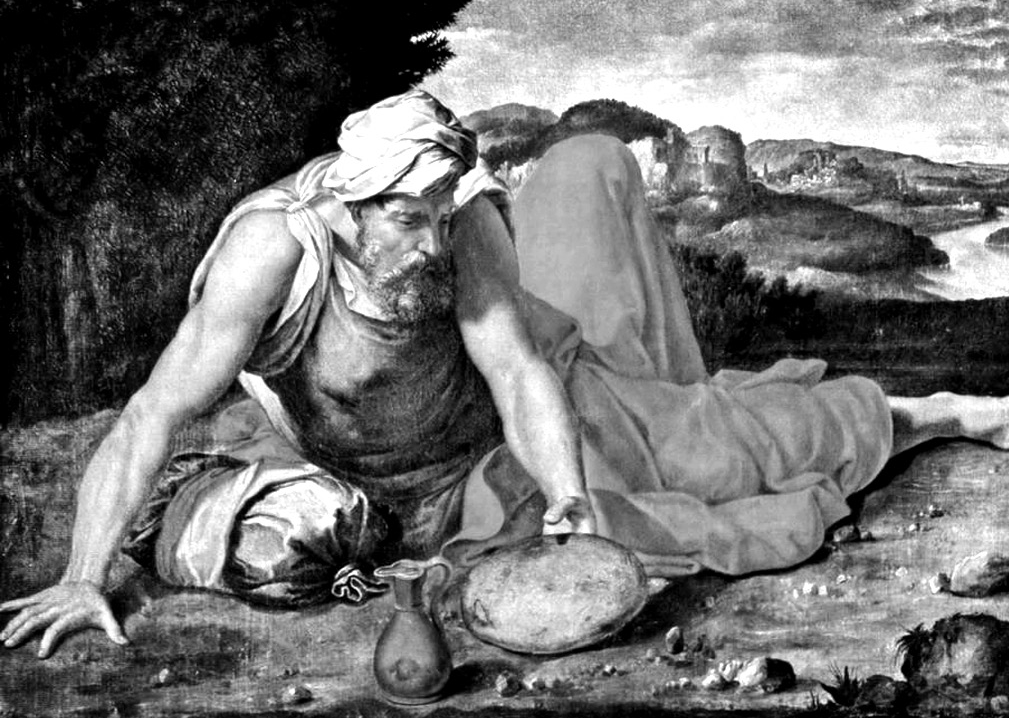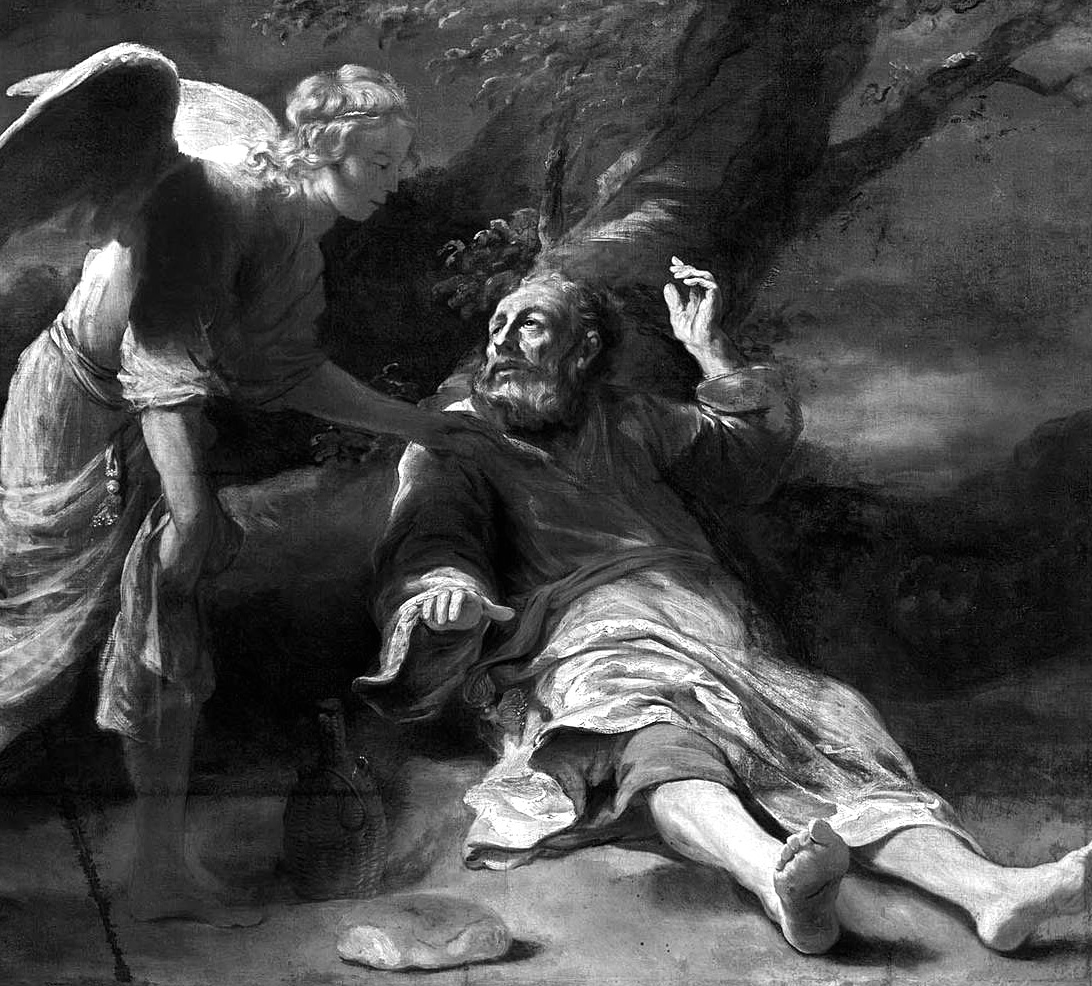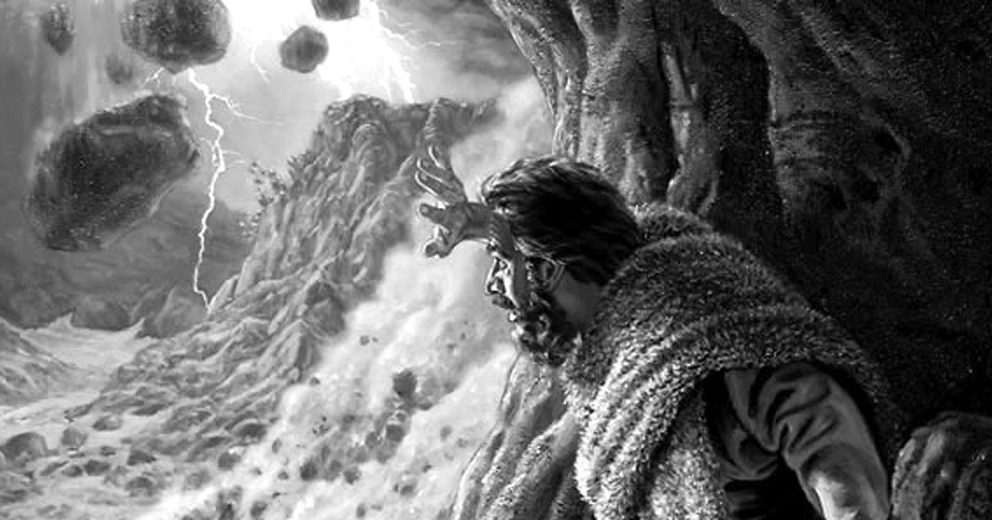Elijah at Mount Horeb
“And he arose, and did eat and drink, and went in the strength of that meat forty days and forty nights unto Horeb the mount of God” (1 Kings 19:8).
Elijah the prophet lived during a time when Israel had strayed from the proper worship of Jehovah. Ever since the kingdom of Israel divided in the days of Rehoboam and Jeroboam, the northern kingdom had begun worshipping Jehovah in an illicit form, depicting Jehovah in two calves of gold. This was a deliberate policy of Jeroboam to avoid his subjects from going to Jerusalem where the Temple of Solomon was the center of worship (1 Kings 12:28). In doing so, Jeroboam caused Israel to violate the second commandment of the 10 that Moses received from God at Mount Sinai (Exodus 20:4).
The kings that followed Jeroboam continued this policy for more than half a century, until the time of Ahab, when a further corruption was introduced. Ahab introduced Baal worship through the influence of his wife Jezebel, and thus violated the first of the 10 commandments, “Thou shalt have no other gods before me” (Exodus 20:3). Such was the apostasy in the days of Elijah.
These lamentable circumstances prompted Elijah the prophet to step forward with this declaration. “As Jehovah God of Israel liveth, before whom I stand, there shall not be dew nor rain these years, but according to my word” (1 Kings 17:1). This punishment on Israel was in keeping with Moses’ warnings centuries earlier: “Take heed to yourselves, that your heart be not deceived … and serve other gods, and worship them. And then Jehovah’s wrath be kindled against you, and he shut up the heaven, that there be no rain, and that the land yield not her fruit” (Deuteronomy 11:16, 17).
This defection in natural Israel represents a defection in spiritual Israel during the Gospel Age. Literal Jezebel induced Ahab to idolatry then, and spiritual “Jezebel,” the apostate church, induced spiritual idolatry during the dark ages (Revelation 2:20). Ahab, husband of Jezebel, represents the political powers that supported Papacy, and faithful Elijah, outcast and fugitive, represented the faithful church depicted as fleeing to the wilderness for safety (Revelation 12:6). The drought of rain in Elijah’s day lasted 3½ years (Luke 4:25), and the drought of truth while the true church was afflicted endured for 3½ prophetic times. That is, 3½ x 360 years, or 1260 years total, from 539 to 1799 (see Volume Three of “Studies in the Scriptures,” Chapter Three, “Days of Waiting for the Kingdom,” specially page 64, bottom paragraph).
END OF THE DROUGHT
After 3½ years, Elijah appeared to Ahab and proposed a contest between himself, as a prophet of Jehovah, and the priests of Baal. In that contest God miraculously consumed the sacrifice Elijah had arranged on his altar, the Israelites were persuaded, the servants of Baal were overwhelmed, and subsequently a great rain ensued. These events pictured the experiences closing the 1260 years of Papal authority. Papacy was put under strictures and taxes by the French government, the rebellious Pope was laid in arms, he died as a prisoner in France in 1799, and Napoleon refused to allow the election of a successor. The Protestant ethic flourished, Bible societies sprang up, Bibles in common languages were distributed by the millions, and the rains of blessing and truth became prodigious. The “two witnesses” — the Old and New Testaments — symbolically came to life again and ascended to great prominence in the ecclesiastical heavens (Revelation 11:11, 12).

Elijah, fed on his way to Mount Horeb
Things looked good for Elijah, until Jezebel heard of his success and threatened his life anew. Elijah needed to flee again, and this time went southward as far as Mount Horeb — another name for the older designation Mount Sinai.1 Elijah’s flight represents that the Church class had other troubling experiences in store after the end of the 1260 years of Papal authority. Perhaps this was fulfilled by the restoration of old monarchies in Europe, sympathetic to Papacy, after the Napoleonic Wars. The Pope no longer officiated at national conclaves. But the “image” of Gentile power was still a mixture of iron (governments) and clay (papacy) until World War I and the world changing events of 1914.
TWO FEEDINGS AND FORTY DAYS
1 Kings 19:1-12 narrates Elijah’s flight. Discouraged, despondent, Elijah was near ready to yield to the wrath of his enemies. He rested under a juniper tree, and “As he … slept … an angel touched him, and said unto him, Arise and eat” (verse 5). He ate of the baked bread, drank of the cruse of water, and then laid down to rest again. This first angelic feeding of Elijah seems to represent a “feeding” of the saints with spiritual nourishment in the early 1800s, and this was just the time that the Adventist Movement took root. In America William Miller was a leading light of this movement, in England Henry Drummond organized productive prophetic studies on his estate, and in Europe and Asia, German-born Joseph Wolff, a Jewish Christian Missionary, had considerable influence. If the angel that provided this first feeding represents a specific agent that “nourished” the church concerning Daniel’s prophecies of the end times, perhaps William Miller is the fulfillment.

Elijah, fed a second time after sleeping
But the Adventists were disappointed. They correctly understood that Jesus’ return was near. They correctly understood some of the time prophecies of Daniel. But some of their conclusions were imprecise. In Matthew 25, in the parable of the wise and foolish virgins, while the bridegroom tarried, the virgins “slumbered and slept,” a parallel to what occurred to Elijah after the first feeding, he “laid himself down again” (1 Kings 19:6).
The virgins were awakened with an announcement concerning the bridegroom. Elijah was awakened by an angel a second time, and said “arise, and eat; because the journey is too great for thee. And he arose, and did eat and drink, and went in the strength of that meat forty days and forty nights until Horeb the mount of God” (1 Kings 19:7,8). The second feeding represents the rich repast of Truth we know as God’s Plan of the Ages. Luke 12:37 tells us that after the return of Christ the Church would receive such a rich spiritual repast. “Blessed are those servants, whom the Lord when he cometh shall find watching … he shall shall … make them to sit down to meat, and will come forth and serve them.” The same promise is given in Rev- elation 3:20 to the Laodicean church, the church of the harvest period of the Gospel Age.
40 YEARS TO 1914
Thus the second feeding of Elijah represents the feast of truth we have received since the return of Christ. As the 1260 years of Daniel 12:7 ended in 1799, the 1335 days of Daniel 12:12 take us 75 years later to the date 1874. This is the reason brethren today who see that Jesus has returned to supervise the harvest work (Revelation 14:14), and the transition of the ages (Daniel 12:1-3), use 1874 to mark the beginning date of the parousia, or presence, of Christ.
Elijah went in the strength of that feeding for 40 days to Mount Horeb. If these days represent years in fulfillment (as it is in the prophecies of Daniel), then this suggests that 40 years after 1874 the saints would “come” to Mount Horeb. That would take us to the year 1914, when the “time of trouble” of Daniel 12:1 commenced. Remarkably, that was the year when World War I commenced, followed by World War II about two decades later, with Armageddon impending at the close of the harvest. In other words, it is now apparent with the aid of perspective that the time of trouble is a broad period encompassing more than a century.
Brethren before and about the time of 1914 did not have the same perspective that the passing of decades has provided us. They supposed the time of trouble would be relatively brief, perhaps a few years. Even at the close of the ministry of the beloved servant, Bro. Charles Russell, in 1916, he anticipated that within “a year or two or three” the church would be complete in glory and the kingdom ushered in.2 However, the time has been expanded.3
WIND, EARTHQUAKE, FIRE
At Mount Horeb, Elijah was shown a vision of the time of trouble in three phases — wind, earthquake, and fire. In each of these the text says “Jehovah was not in” these things, but afterward Elijah heard a “still small voice” which represented the blessings Jehovah would bring in a quieter, more pleasant time, following the trouble.
Perhaps what Elijah himself saw in these things is that the peaceable instruction in righteousness among the Israelites was not accomplished through the tumultuous events he had recently experienced. Those dynamic events were necessary. But to turn hearts to God and invest them with faith, trust, and appreciation, requires peaceful, Godly instruction. That would come through the patient instruction of Elijah that followed.
There was work to be done. Elijah thereafter went back to Israel and served the school of the prophets that did inculcate godliness among the Israelites. Likewise, the time of trouble we are presently passing through, which is a necessary prelude, will be superseded by the quieter, pleasant, patient, and enduring teaching in the hearts of the world of mankind during the blessed Millennial Kingdom of Christ.
THREE STAGES
It is feasible to suppose that the wind, earthquake, and fire that Elijah witnessed represent three stages to the time of trouble, specially as we now know from observation that the trouble is a protracted period of decades taking us greater than even a century. (For it has been a century since 1914, and evidently some years remain before the Kingdom is established.)
Wind in scriptures is a picture of war (Daniel 7:1). An Earthquake represents political upheaval (Revelation 11:13). Fire represents an unstructured, more radical feature of trouble, sometimes supposed to be anarchy, or some form of organized trouble without governmental control or checks.
We suggest that (a) the wind represents a war phase, which history shows to have been in two major blows, World War I and World War II. This phase commenced in 1914, and run to the close of World War II in 1945.
(b) Following the second world war came an “earthquake,” the dissolution of the major European colonial empires. India gained independence from England in 1947, Israel gained independence in 1948, much of Africa and Indochina in the 1960s and 1970s, and the fall of the Soviet Empire came in 1989 when Poland, East Germany, Czechoslovakia, Hungary, and Romania were freed.
(c) Not long after 1989 the focus of difficulties became the Arab countries where Islam is widespread. The first Gulf War began the following year with Iraq’s invasion of Kuwait, The attack on New York by Al Qaeda followed in 2001, and the second Gulf War began two years later. Terrorism and turmoil have continued ever since then. Evidently this stage of trouble will continue until the close of the harvest.4 5

Elijah’s vision of the Time of Trouble
THE TIME POINTS INVOLVED
The three broad phases of the time of trouble give us a scriptural “overview” of our time. Each of these phases is decades long. The wind phase takes us to 1945, the earthquake phase takes us to 1989, and the fire phase introduces us to the Kingdom when the “still small voice” will lead the world to peace.
Here we observe an interesting symmetry on either side of the 40 years from the Return of Christ (1874) until the Time of Trouble (1914). In the Elijah picture, the date 1799 is represented in the close of the 3½ year drought. The expectations of the Adventists (the first feeding of Elijah) was for Christ’s return in 1843.6 The actual return of Christ at the close of the 1335 years was in 1874.
From 1799 to 1843 was a period of 44 years and from there to the return of Christ was another 31 years. Forty years later brought us to the Time of Trouble in 1914. Thereafter, until 1945 was a period of 31 years, and until 1989, 44 years more. This symmetry — 44, 31, 40, 31, 44 — suggests design and intent. These are not simply random periods. This strengthens our opinion that, collectively, we have understood the prophetic periods correctly.7
STILL TIME
All indications are, from the responses to the Truth in various countries, that the High Calling remains open for those who wish to enter, and it is being embraced. At some point before the end of the harvest this work presumably will taper down, for new entrants to the heavenly call- ing require years of time to cultivate the new creature. However, most brethren sense that within a generation the harvest will close and the kingdom will be established. This expectation seems consistent with the Elijah picture. We have some years remaining for active service.
— Br. David Rice
(1) This connection links Moses and Elijah in an engaging way. They are also linked in that each of them fasted for 40 days, something unique to these two prophets in the Old Testament. Moses and Elijah are the “two witnesses” in Revelation 11:6 that represent the Old and New Testament. Malachi’s closing prophecy of the Old Testament, predicting the coming of Jesus as the Messenger of the (Abrahamic) Covenant. Moses and Elijah appeared in vision with Jesus on the Mount of Transfiguration, testifying about Jesus, who also fasted for 40 days.
(2) Volume Three of “Studies in the Scriptures,” Foreword, page i, paragraph 4.
(3) One reviewer notes — “However, a goodly number of Bible Stu- dents in 1914 were not expecting October to be spectacular. E.g., George B. Raymond and a few others at the Columbus convention, 1914 June/July. (A Bible Student lore has now grown up forgetting about them.)”
(4) 2 Kings chapter three probably depicts the resolution of the conflict between Israel and the Arab world at the end of the harvest.
(5) Those who think that the harvest period may also be represented in the travels of Paul in Acts chapter 27 will see a parallel to these phases. Paul first journeyed to Sidon where he had sweet fellow- ship with the saints, depicting the first 40 years of the harvest up until World War I. Thereafter the ship Paul sailed in met stiff winds (wars), and encountered this in two parts, in the Sea of Cilicia and the Sea of Pamphylia.
At Myra, on the underside of Asia Minor, Paul’s company changed ships, just as the ship of state in old Christendom (Europe) changed after World War II. They sailed westward to the last extremity of land, the peninsula port of Cnidus, the last port of call on the mainland. This takes us to the “new world order” following the close of the Soviet Empire. In the third part of the journey Paul’s ship was buffeted by billows, barely passing Salmone, coming to Fair Havens for some respite, before being overtaken in the storm which ultimately ruined the ship.
(6) 1843 was the year that Bro. Miller calculated for the return of Christ. The prolonging of the time to 1844 he supposed to be from the grace of God allowing probation until the end of the spring to spring year introduced in 1843. The date October 22, 1844, was promoted an Adventist named Bro. Snow. This date was fixed as the Day of Atonement for that year. They considered that date auspicious enough to mark the return of Christ. After the passing of that date, there was widespread disappointment.
(7) There is another point of interest in Elijah’s experiences. Here are five notable points in the episode — Elijah’s confrontation with the priests of Baal, his first feeding, laying down to sleep, his second feeding, and arriving at Horeb 40 days later. The dates associated with these in fulfilling the picture are 1799, 1829, 1843, 1874, 1914. These align well with the five prophetic periods of Daniel — 1260, 1290, 2300, 1335, and 2520 years.
